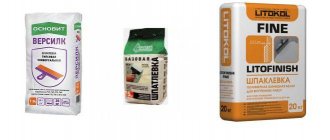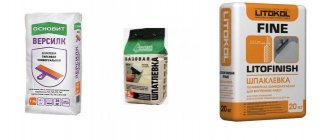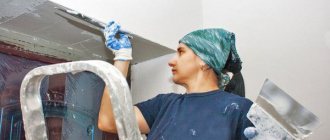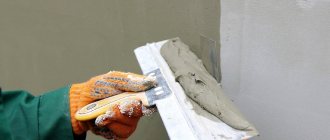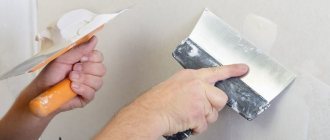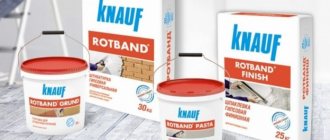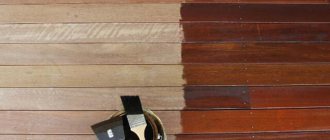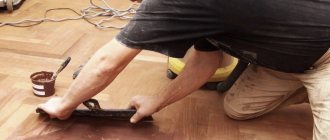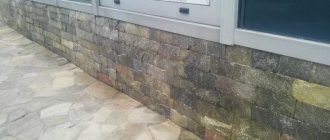Using putty, you can significantly improve the aesthetic and technical characteristics of the surface of a wooden or concrete floor, increase its resistance to external influences and, in the case of a wooden floor, maintain a unique wooden texture for a long time. Floor putty is used to eliminate defects that appear during the operation of the floor, as well as for high-quality preparation of the base for decorative finishing. How to choose the composition and do the job correctly? We'll tell you in this article.
Floor putty
Putty for concrete floors: features of selection and work
Putty for concrete floors is a special building material that is supplied in the form of a dry or liquid mixture that requires preparation, intended for finishing surfaces in order to implement various tasks. Most often, concrete floors are covered with putties to give them the necessary characteristics of rigidity and strength, extend their service life, level them, and prepare them for finishing.
A concrete floor experiences high mechanical loads and must be as reliable, wear-resistant, and able to withstand aggressive influences. Due to the peculiarities of the porous structure of a concrete monolith, untreated concrete can become dusty and deteriorate over time, subject to the spread of a network of cracks and the appearance of other deformations (chips, potholes, etc.).
Even if you plan to finish the concrete with a floor covering, pre-treatment of the surface will extend the service life of the finishing layer and eliminate a lot of problems. One way or another, concrete reinforced with putty demonstrates increased characteristics of durability, comfort, and strength. In addition, putties are used to level concrete in the presence of small differences.
Acrylic mixtures
One of the most convenient forms - it hardens quickly and creates a smooth surface. The multi-component system is not subject to shrinkage and is not afraid of water.
In addition to water, the composition of polymer putty for concrete floors includes sand, marble chips, cement, and synthetic additives. This putty is plastic, has good waterproofing properties and adhesion to the surface being treated, is waterproof, and elastic, which makes it an excellent material for preparing surfaces for self-leveling and heated floors. But its use is advisable on surfaces with a small number of deep cracks and gouges.
Price for polymer putty
Application of putty
Most often, concrete floors without finishing material can be found in industrial buildings - factory workshops, garages, retail and warehouse premises, etc. Here the most important requirement for concrete is strength to mechanical loads and wear; in addition, floors are provided with resistance to physical and chemical influences, temperatures, moisture, etc.
For which coatings is treatment with putty for a concrete floor relevant: under parquet and parquet boards, laminate and linoleum, ceramic tiles and painting, porcelain tiles and self-leveling polyurethane floors. These materials require a perfectly smooth and even surface, resistant to mechanical damage and moisture, capable of not crumbling, cracking, or dusting.
Gypsum mixtures
Eco Finish gypsum finishing putty
Gypsum-based putty mixtures are the least popular option for leveling the surface of concrete floors. The advantages of this material include:
The gypsum composition creates a perfectly smooth surface from the first layer, dries quickly and can be colored with any color (as a more budget-friendly option, you can use artistic gouache), however, it has one significant drawback - the material is not suitable for rooms with high humidity.
Price for gypsum putty
Properties
Putty is selected in accordance with the functions it must perform. So, for example, for floors in industrial premises it may be important to ensure maximum wear resistance and strength, for certain residential premises - to minimize exposure to moisture and temperature changes.
Putties are selected according to the type of finishing coating, the purpose of the room, the functions of the floor and other factors. The modern market offers a fairly large selection of various compositions, most of which meet basic requirements, while for specific ones it is important to select specific substances.
Types of putties for concrete floors
Any putty is a mixture of binding components with water, with the possible introduction of fillers (crushed stone, sand) and additives to increase plasticity. The binders usually include cement, glue, epoxy resins, polyester, and polyurethane. The market offers a large selection of putties in different formats - ready-to-use mixtures, one/two/three-component dry compositions (requiring mixing with water before use).
Due to the high cost of putty compositions for concrete, they are often made by hand - from drying oil, sand, cement, acrylic varnish, PVA glue, etc. But it is impossible to guarantee quality and compliance with the required characteristics when using such products.
When choosing the type of mixture, they take into account the properties and type of base, the purpose of the room, the technical parameters of the solution, and the assigned tasks. Thus, the coating may require the elimination of many defects or require a high level of vapor permeability, strength, etc. If you plan to lay a finishing finish on top of a concrete floor, be sure to take its properties and features into account.
Plaster
Gypsum-based mixtures are considered the most common and relatively affordable.
Cement
Such mixtures are usually prepared with your own hands and used to level the concrete floor under typesetting or sheet floor coverings.
Special
Special-purpose mixtures in the composition may include special components designed to lower or increase certain indicators, improve certain properties intended for floors in a certain condition, coatings of various types.
Often such putties demonstrate increased values of frost resistance and water resistance, are not afraid of very heavy loads, sudden temperature changes and, in general, demonstrate more serious characteristics that are important for production and premises for certain purposes.
Acrylic
Ready-made paste putty created on the basis of reinforcing fibers and acrylic copolymer. The main task of such a composition is to repair deformed foundations, seal cracks, seams, and joints.
The material has practically no disadvantages.
Epoxy
This type of putty is used when it is necessary to level and strengthen a concrete floor with noticeable damage in the form of embroidered seams, large cracks, and traces of removed reinforcement. The epoxy composition tightens the concrete surface well, increases service life and strength.
Waterproofing putty for further sanding of floors
Waterproofing putty demonstrates increased moisture resistance due to its urethane components, dispersion emulsion, targeted additives, and dry base. The substance can be used as an independent coating.
It is often used for the restoration of old concrete surfaces where humidity is high (steam room, bathroom, shower). The main advantage of the composition is that it is not necessary to wait for it to dry completely; you can continue to work on the wet layer.
Puttying under linoleum
This type of work is carried out in compliance with certain rules, since the floor under the linoleum must be dust-free, perfectly smooth, without any defects, capable of withstanding considerable loads (transmitted from the linoleum) and point impacts.
Wooden floor
Wood putty is used not only when installing a new wooden floor, but also for restoring existing flooring. With its help, you can effectively eliminate defects and qualitatively prepare the flooring for final finishing. Putty is used when laying parquet - this is one of the important stages that improves the aesthetic and technical qualities of the coating and increases its resistance to various influences.
Parquet laying
When working with old floors that are to be painted, putty is applied at the preparatory stage in order to level the flooring and remove cracks, irregularities and other defects.
Modern manufacturers offer a wide range of putties for working with wood. Their main qualities include the following:
- Homogeneous texture and absence of foreign inclusions.
- High adhesion, ensuring reliable adhesion of the putty to the wood.
- Elasticity is an important factor given the tendency of wood to expand due to temperature.
- Availability of antiseptic additives.
- Quick drying and easy interaction with wood.
- No cracks after drying.
- Easy sanding.
Note! One of the important requirements for wood putty is that it shrinks minimally, so that you can get by with just one coat.
Types of putty for working with wood
On sale you can find a large selection of putties for wooden floors, the difference between which lies in the type of base - oil, water, polymer, solvents. In addition, manufacturers offer a wide range of composition shades, which allows you to choose the material for any type of wood - birch, oak, walnut, wenge and others.
Applying putty with a spatula when laying parquet
Water-based putty
The water-based putty is environmentally friendly and safe to use, easy to use, flexible and does not emit a strong odor during application. The viability of such a solution is much longer than that of solvent-based analogues. Excellent adhesive properties allow this type of putty to be used even on polished substrates.
Water-dispersed acrylic putty for wood
The advantages of water-based putty include the following:
- Allows you to effectively remove defects in wood flooring.
- Aligns joints.
- Does not contain chemicals.
- It is moisture resistant .
- Creates a durable coating .
- Resistant to temperature changes.
- Has an elastic structure .
water-based floor putty
Solvent putty
pros
- Solvent-based putty is characterized by high strength , which has made it especially in demand for woodworking enterprises.
- A plus is its compatibility with any type of wood , even exotic ones.
- Another advantage is the quick drying of the composition.
Minuses
The disadvantage is the strong odor, which requires the use of a respirator when applying the composition and gloves.
Solvent based putty
solvent putty
Oil solution
Oil-based putty has excellent water-repellent properties and makes the wooden coating resistant to mechanical stress. Thanks to a wide range of shades, you can choose a composition for any type of wood.
Oil-adhesive putty
pros
Oil putty for wood has the following advantages:
- High ductility .
- Long service life.
- Affordable price .
- High adhesion to wood.
- Moderate consumption not exceeding 1 kg per m².
- Convenient use of the finished composition.
- Quick drying .
- Convenient packaging in buckets of different sizes.
- Environmentally friendly.
Minuses
- The disadvantage of the composition is its long drying time.
- Vulnerability to moisture
- Doubtful adhesion with any paint and varnish compositions except oil-based ones. Therefore, when working with old coatings, it is necessary to completely remove the old coating from their surface.
oil putty
Staining wood floors is one of the most common ways to finish them. But even with all its simplicity, it requires a competent approach, if only because the paint for the floor must meet certain criteria. How to choose a good floor paint yourself? Read in the special article.
Polymer-based composition
Polymer acrylic or latex putty is most often used to treat wooden floors or parquet.
Recommendations for the use of acrylic putty
pros
The advantages of acrylic composition include the following:
- The material is resistant to temperature changes.
- Has water-repellent properties.
- Resistant to significant loads.
- It has the necessary elasticity and effectively fills small cracks , voids and joints.
- Does not shrink.
- Durable and environmentally friendly.
- Available in a wide range of shades.
- Dries quickly.
Minuses
The disadvantage is
the high cost, but it pays off with the long service life of the coating.
Wood floor putty technology
Table3. The process of puttying wood flooring
| Illustration | Description |
| The preparatory stage involves cleaning the floor from dirt and dust. The base for putty must be dry and clean. | |
| The solution is prepared in strict order according to the instructions indicated on the package. | |
| A small amount of solution is poured onto the floor and spread over the floor surface using a spatula. | |
| After the composition has dried, the floor is sanded several times, increasing the grain size of the sanding element. |
Note! You can get a strong and durable coating by applying several thin layers instead of one thick one.
Technology for leveling the floor with putty during do-it-yourself repairs
Before starting puttying, the concrete surface is thoroughly cleaned of debris and dust - for this you can use a construction vacuum cleaner or an ordinary broom. Next, priming is carried out to ensure better adhesion of the materials.
The putty is simply poured onto the floor, and then carefully leveled with a spatula or a special brush over the surface. This makes it possible to obtain a thin coating that is as evenly and evenly distributed as possible over the floor. After the work is completed, the room should be wet cleaned and everything should be thoroughly cleaned.
The modern market offers a fairly large selection of various putties for concrete floors that meet various requirements, guarantee the required characteristics and must be used strictly according to the instructions.
Source
Features of working with linoleum
This type of finishing coating is demanding on the quality of the rough base. The floor must be smooth, without humps, depressions, cracks, or sinkholes. If you lay linoleum on an unprepared base, it will soon begin to wear out and tear in places where there are obvious bulges - its service life will noticeably decrease. To avoid this, putty the floor, and then lay a special layer under the finishing coat.
Sealing of unevenness is possible only on a foundation of fairly decent quality, with a small difference in level and a small number of errors. If there are bumps and holes at every step, you will have to first pour a self-leveling concrete screed and only then start laying linoleum.
What mixtures are suitable for restoration?
Acrylic
Acrylic composition is used to level floors with minor defects (chips, cracks, potholes). Suitable for restoration of floors on which parquet or linoleum will be applied. No solvents are used for use. The composition looks like a thick, stretchy paste that is easily distributed over the surface with special tools.
At sub-zero temperatures, the acrylic composition has one drawback - it loses elasticity. Advantages of acrylic putty:
Due to the fact that acrylic putty has very high performance and technical characteristics, its price is much higher than other analogues.
It must be applied in a very thin layer (about 1–2 mm). In this case, it will be possible to avoid cracking of the surface after complete drying.
Polymer for wood coverings
The polymer mixture is also called latex or acrylic. Its use is justified for wooden floor coverings and parquets.
The mixture consists primarily of water. Suitable for coating on wooden surfaces due to its high leveling properties. The composition does not shrink; it is enough to cover the surface with one layer of putty. Polymer compositions have a number of advantages:
Quick drying
It contains solvents and plasticizers. It has a pungent odor that dissipates within a few days after application. The advantage of applying a quick-drying mixture is its uniform distribution over the entire pouring area, filling all joints, cracks and kinks.
The base is pre-cleaned well and treated with a primer. This is necessary for a better fit of all subsequent materials. To work, you will need beacons that will indicate the height of the screed above the level of the walls. After distributing the self-leveling mixture, wait about an hour and pull out the beacons. The recesses from them are sealed with the same putty material.
The advantage of applying such a mixture is the minimal investment of labor costs. The surface is perfectly leveled with one tool - the rule. Manipulations with it are quite simple.
Oily
Oil mixtures have a high water-repellent effect and provide surface resistance to mechanical stress.
Thanks to the wide range of shades of oil putty, you can choose it to match any wood texture. The advantages of using an oil mixture are as follows:
Plaster
Suitable for puttying concrete floors. Among the advantages are low cost, no shrinkage after leveling. Before applying the composition, you need to prepare the base. The quality of application will depend on the condition of the floor. It must be cleaned of all excess debris and dust.
If necessary, primer will require several coats of primer . This must be done if the primer is immediately absorbed the first time. The gypsum composition lays down and hardens on the surface in an even layer. The finished surface can be colored with artistic gouache in any color.
A significant disadvantage of gypsum putty is its sensitivity to moisture. This composition should not be applied in the bathroom, kitchen, or in rooms with high moisture concentrations.
Two-component epoxy
Suitable for strengthening and leveling concrete bases with visible significant defects (seams, crevices, cracks and joints). A two-component epoxy mixture binds concrete well, increases its strength and durability.
Advantages of mixtures:
Cement based PVA
It has a composition of fine fractions, so it fits and dries perfectly on the concrete surface. Before applying, you need to clean the floor from the previous flooring and smooth out all roughness with sandpaper. If there are deep cracks, then they are thoroughly cleaned and deepened. Then they prime the surface, wait for it to dry, and begin cementing work.
PVA-based cement putty is notable for the fact that, due to the addition of glue, it spreads perfectly over the base and captures all hard-to-reach places. It will take effort to level the mixture, but you don’t have to worry about the reliability of cementing small and large cracks.
Waterproofing
These mixtures are used to level surfaces in the bathroom and kitchen. Select dry and ready-made putty. Ready-made is sold with all the necessary components and additives. To install it, you don’t need to mix anything additional. But dry requires mixing yourself with the amount of liquid indicated on the package.
Advantages of waterproofing mixtures:
Types of compositions and their properties
A wide range of putty mixtures on the modern construction market allows you to choose the composition for a specific case. The following types of putty are distinguished.
Table 1. Types of compositions
| Image | Type of composition | Description |
| Acrylic | Contains solvents. Supplied as a thick paste. It has low elasticity at low air temperatures. The advantages include excellent adhesion, effective processing of seams, the absence of harmful substances in the composition, and resistance to high temperatures. | |
| Polymeric | Has a polymer base. It is used as a leveling compound before laying a finishing coating based on natural wood. Does not shrink. | |
| Latex | It has high adhesive strength, so it requires some skill in performing such work. The advantages include excellent adhesion and elasticity. Allows high-quality sealing of very small joints. Disadvantages include high cost and the need to operate only at positive ambient temperatures. | |
| Quick-drying (nitro putty) | Contains plasticizers and solvents. It has a pungent odor. The advantages include a wide range of colors, high adhesion to wood, and quick drying. | |
| Oil | It has water-repellent properties and makes the treated surface durable. Can be used for both interior and exterior work. Contains water, oil and chalk. | |
| Plaster | Used for interior work in dry rooms. Environmentally friendly and safe product. Vulnerable to moisture. | |
| Epoxy (two-component) | Requires experience and high speed of high-quality application, as it hardens quickly. It has strong adhesion to concrete surfaces and creates a very durable coating. | |
| Cement | It is characterized by low cost and long drying time (at least 6 hours). | |
| Waterproofing | For work in rooms with high humidity - in bathrooms, saunas, baths, swimming pools. |
All of these varieties are characterized by two forms of release - dry and ready-made. In the first case, you will need to prepare it yourself, taking into account the manufacturer’s recommendations indicated on the package.
Dry formulations have the following advantages:
- Long shelf life.
- Convenient for storage and transportation in bags.
- Affordable price.
- Versatility of use.
Preparation of a solution from dry ingredients
Ready-made compositions include options based on acrylic, polymer, latex. They go on sale in buckets or iron cans. The main advantage of this putty is that the manufacturer cannot make mistakes during its manufacture - all components are mixed in the required proportions, which means you don’t have to worry about the quality of the mixture. Disadvantages include high cost and demanding storage conditions.
Separately, it is worth noting water-based putties:
- This mixture contains a minimal amount of additives.
- It has no smell.
- Easy to use.
- Perfectly seals any defects.
- It is characterized by high elasticity.
Note! Another criterion for choosing a putty is the use of the mixture for a certain stage of work. In this regard, putty can be initial (to prepare the surface) and finishing.
How to choose the optimal recipe for leveling?
Under laminate
The base for the laminate must be flat, without significant differences in height (no more than 2 mm). If the base meets the conditions, then the laminate can be laid on a wooden or concrete floor. A self-leveling mixture is suitable for leveling such surfaces.
If you take tile adhesive as a rough option, the process will be much more complicated and will require additional costs.
On wood
The wooden base very often rots and cracks .
The boards are replaced with new ones, that is, the rough surface is completely dismantled. Leveling is done with thick plywood boards (thickness of at least 12 mm). Cement mortar is good for pouring: it hardens quickly and gives good installation. It is also good to lay a waterproofing mixture on wood, since wood is susceptible to moisture, and with such a composition it will be completely protected from external factors. This is the most suitable composition for wood.
Varieties of putties for different types of base
| Photo | Name | Rating | Price | |||
| Putty for working with concrete | ||||||
| #1 | Gypsum mortar | ⭐ 98 / 100 | More details | |||
| #2 | Cement mortar | ⭐ 96 / 100 | More details | |||
| #3 | Acrylic mixture | ⭐ 95 / 100 | More details | |||
| #4 | Epoxy composition | ⭐ 95 / 100 | More details | |||
| #5 | Waterproofing solution | ⭐ 92 / 100 | More details | |||
| Types of putty for working with wood | ||||||
| #1 | Water-based putty | ⭐ 91 / 100 | More details | |||
| #2 | Solvent putty | ⭐ 90 / 100 | More details | |||
| #3 | Oil solution | ⭐ 93 / 100 | More details | |||
| #4 | Polymer-based composition | ⭐ 96 / 100 | More details | |||
Expert answer
It is best to level the surface of a self-leveling self-leveling floor for laying soft or semi-rigid finishing coatings with the same composition that was used for arranging the base. Before you start working, take a long rule or a flat strip and find all the protrusions and depressions on the poured surface. During the search, mark defective areas with chalk or pencils of different colors - this will simplify their identification in the future.
Protrusions and wrinkles can be removed with a sanding machine. In addition, all recesses and other defective areas should be sanded with sandpaper. After this, the floor surface is vacuumed (it is not recommended to wet the self-leveling floor) and leveled using putty, which is applied with a long spatula. What material to use in this case – gypsum plaster or self-leveling floor – decide for yourself. In the latter case, we recommend using a thicker mixture for plastering work.
Without waiting for the putty to dry completely, the surface should be smoothed with a plaster trowel. The final stage of the repair work is the final sanding of the floor with sandpaper installed in a holder at least 30 cm long. In order to increase the resistance of the gypsum self-leveling floor to abrasion, its surface can be coated with a polymer primer. Among other things, it will improve the water-repellent properties of the floor and increase its adhesive ability. The latter will certainly be useful when installing the finishing coating.
Source
Waterproofing polyurethane material
Waterproofing is characterized by increased resistance to the effects of organic and mineral environments, mechanical strength against tearing and compression.
Waterproofing putty is used both in combination with other materials and as an independent coating.
Application
Scheme of concrete hardeners.
- This type is used for waterproofing concrete floors, for sealing cracks (including small ones) and for creating a waterproofing protective layer under a self-leveling floor system. The putty can be applied to a damp base and to fresh concrete;
- putty is used for waterproofing water tanks and swimming pools, under cement screeds and tiles, wastewater treatment plants and sanitary facilities, as well as for external waterproofing of foundations;
- this waterproofing coating is environmentally friendly and can be used in explosion and fire hazardous areas;
- consumption depends on the thickness of the layer and is 1.5-4.0 kg/m2;
- after completion of work, the tool is cleaned with water;
- The composition includes a 3-component urethane compound, consisting of a semi-finished product (urethane film former with targeted additives and an aqueous dispersion), a dry mixture and a hardener.
Storage
- the semi-finished product is stored at a temperature of at least +5°C;
- The shelf life of hydrospar in original packaging is 12 months from the date of manufacture.
Putty for self-leveling floor. Putty for concrete floors - nuances of choice
Similar work can be carried out on a concrete floor using a base, finishing or universal putty material. However, the most attractive will be self-leveling compounds, which greatly facilitate the finishing process, since they independently fill in unevenness and form a smooth surface, which can then be used as a basis for further finishing. This material is based on the same concrete, but there are also additives such as polyurethane and polyester. What is their difference:
Important! An alternative would be urethane putty with waterproofing properties. This material is attractive not only because it is resistant to water, but also to various organic substances, as well as physical impact. The material can be used in rooms with a high fire and explosion hazard, as well as where complete environmentally friendly finishing is required.
Choice depending on the type of base
One of the main criteria for choosing a putty is the type of surface you will be working with. This can be wood (boards, plywood, parquet, fiberboard or chipboard), gypsum fiber sheets or concrete. To work with the latter, cement putty with a waterproof effect is used. With its help it is possible to produce a very durable surface.
Parquet putty
Each type of base requires special qualities from the putty. So, for working with wood, the composition should be:
- Plastic throughout the entire stage of work.
- Do not form cracks on its surface after drying.
- Create an organic combination with paintwork finishes.
When working with chipboard, the working composition should not shrink. This quality is typical for acrylic, latex and silicone putties. Oil and adhesive compositions successfully cope with large cracks.
Self-leveling floor errors. Mistakes when pouring self-leveling floors and eliminating coating defects
The widespread use of self-leveling floors has long been a fait accompli. The installation of such floor coverings is not a complicated process, so it is often done by the owners of residential premises on their own. In this case, one nuance arises.
People involved in the installation of self-leveling floor coverings professionally know the technology with all its subtleties, have acquired the necessary experience and, accordingly, perform the work efficiently.
When we try to do it ourselves, without experience, and most importantly, without fully understanding the details, a defect may subsequently appear that will require repairs.
There are two main reasons why it is necessary to repair self-leveling floors:
Defects of self-leveling floors and ways to eliminate them
The first defect may occur due to the fact that the polymer was poured in a very thick layer.
Repair consists of removing the defective area. Then the concrete base is cleaned of all, even very small, foreign particles (with a vacuum cleaner) to improve the adhesion of the new polymer to the base. After this, the coating is carried out with the same polymer. The second defect, a rough or wrinkled surface, occurs when the viscosity of the polymer composition is very high. For this reason, it is not able to spread evenly over the surface, while quickly hardening. In order to eliminate such undesirable phenomena, it is necessary that the polymer be relatively liquid. When repairing such defects, you need to remove the old damaged layer and apply a new, more liquid layer to this area.
Sometimes the polymer layer peels off from the concrete base. There may be several reasons for this polymer behavior. This includes poorly removed dust and dirt from the rough base before pouring, which clearly impairs adhesion, as well as if the base is over-moistened or has grease stains on it.
We carry out repairs as follows. Using a grinder (circle on concrete), we remove the damaged areas, including the concrete base of the floor, which is the root cause of such a defect. After that, we fill it again, not forgetting about all the subtleties of arrangement - cleanliness, evenness. Then we fill the polymer layer.
It should be noted the prevalence, and at the same time, the difficulty of correcting this defect. The damaged surface area is often very large, so it is likely that the entire floor will have to be replaced.
In case of defects associated with the accidental entry of foreign objects and pieces of debris into the floor structure and frozen in it, repairs are simple. This area is processed with a grinder, after which it is filled with a newly prepared polymer composition.
To avoid such cases, you need to not only thoroughly clean the concrete base of debris, but also monitor the cleanliness of the tools involved in the work.
It happens that the frozen polymer composition becomes cloudy or delamination occurs. This is due to the fact that the consistency of the polymer is runny, or it is simply poorly mixed. The correction for this defect is to pour a new layer of polymer directly onto the old one, i.e. the old one is not removed. But this is possible if there are no other flaws described above.
At the end of our brief review, it becomes clear that the technology of pouring self-leveling floors, although relatively simple, has a number of seemingly insignificant nuances, non-compliance with which has its price, both material and, to some extent, psychological. There is no need for unnecessary nervous breakdowns and then wasting time and patience on repairs. Therefore, when doing the work yourself, be careful when studying the instructions and be careful when carrying out work.
Puttying a cement floor. Concrete floor putty
When renovating, it is important to qualitatively prepare all surfaces for coating and decoration, be it a wall, floor or ceiling. The concrete floor itself is very strong and reliable, but sometimes it has cracks, chips and crevices.
To avoid huge costs for floor repairs in the future, you need to use building mixtures and putties.
Treated concrete floors have a number of advantages: high wear resistance, low likelihood of erosion, less susceptibility to abrasion, chemicals and moisture.
I putty Paul. Preparation for linoleum. I work MP-75 and Rotband.
I putty Paul. Preparation for linoleum. I work MP-75 and Rotband. If necessary, you can putty the floors or...
Description of putties
There are different types of putties: base (applied as the first layer to eliminate the main irregularities), finishing (applied in a final even layer) and universal (suitable for all actions, much more economical and profitable due to low consumption).
By release form you can find: dry, which need to be diluted with water, and paste, which are ready for use. In cases with concrete floors, it is necessary to use a mixture of liquid consistency, as it self-levels.
Pros and cons of different putties
The composition of the putty is: Hydrospat
Putty mixtures for concrete
Putty materials can be basic and finishing. But there are also intermediate universal options suitable for all operations; they are much more economical and have low consumption.
Putty for concrete floors
Based on their component composition, mixtures of the following types are distinguished:
Basic putty PROMOTERS 5 kg
Often, manufacturers additionally enrich the putty with polyester or polyurethane additives. Such materials have minimal shrinkage and high waterproofing properties.
According to the form of release, the mixtures are:
Alpina Feinspachtel finishing putty for treating walls and ceilings made of gypsum boards and concrete
Depending on the application method, the putty can have a liquid or thick consistency. The first type is typical for self-leveling compounds used for treating concrete floors. Such mixtures, under their own weight, are effortlessly distributed evenly over the entire surface, characterizing the continuous puttying technique.
Epoxy putty for concrete floors. Putty for concrete floors - is it necessary and which one to choose?
Greetings to the distinguished assembly. Need advice on concrete flooring. I'm renovating an old apartment on the ground floor. I opened up the floor covering to the very base, I plan to insulate the floor. In the rooms there are logs and mineral wool, in the bathroom there is expanded clay under a dry screed. But the concrete is all cracked. Tell me, do I need putty for a concrete floor in my case if a film vapor barrier is to be installed under the insulation?
If necessary, which one is better to take so that it is suitable for all rooms?
Thanks for the answer. Ivan.
Sealing cracks and puttying concrete floors
And we welcome you, Ivan. And we answer your question in the affirmative: yes, it is very desirable for a concrete floor, in your case. Of course, if you want to make high-quality repairs and not return to it in the coming years.
Why do you need putty?
The point is not that some kind of instruction requires repairing errors in the foundation before insulating and finishing it. This is a time-tested technology, the implementation of which will allow you to be confident in the quality of the work and will lead to long-term and trouble-free operation of the floor.
What gives you such confidence? What the treated surface is:
If there is a basement under the house, dampness may leak from there through the cracks. A common consequence of this is the appearance of black mold. Insects can also enter the apartment along them.
In a word, it is better to repair the base. It’s easy to do it yourself, but it’s up to you to decide which mixtures to use. Our job is to tell about their features.
Types of putties
Putties for concrete floors vary in composition and method of application. They are basic, finishing and universal.
Advice. Since you just need to fill cracks and potholes without leveling, finishing materials need not be considered. The best option is universal formulations.
So, how to putty a concrete floor, what mixture should you use?
Plaster
The advantages of gypsum putty are the absence of shrinkage after drying and low price. But it is not suitable for the floor, as it is afraid of moisture.
Cement
The most common material for repairing such surfaces is a dry cement-based mixture.
It has the following advantages:
These are exactly the properties you need. And even shrinkage of the cement mixture after drying in your case is not a significant drawback affecting the quality of the finish. All the same, the surface will not be visible.
We can stop there – suitable material has been found. But there are others that are more convenient to use or used in difficult cases. Let's talk about them too.
Polymer
It is made on the basis of synthetic resins and contains, in addition to them, cement, marble chips and other components. It comes in ready-to-use form, which is very convenient. But it's expensive.
Ready-to-use polymer putty
Advice. Before you putty the floor, evaluate the amount of work to be done. If a lot of material is required, it is hardly worth spending a large amount on expensive putty.
Advantages of polymer compositions:
Epoxy
The epoxy mixture consists of two components - a base and a hardener, which are mixed before use.
Thanks to these qualities, this composition very efficiently fills even large cracks and voids, creating a wear-resistant coating. It is used when the base is severely damaged, there are voids on it from dismantled pipes and fittings, joints between slabs, etc.
The photo shows filling potholes with epoxy putty.
Epoxy putty literally tightens the concrete in damaged areas, effectively strengthening such areas.
Calculation of cement mortar
Conclusion
You will learn how to use floor putty in the video
In this article. As for the choice of material, the decision is yours. Cement compositions are the most affordable and versatile. Polymer – easy to use, flexible. And epoxy ones are indispensable for serious damage to the surface.
We hope that now you can choose for yourself what to putty on your concrete floor.
Waterproofing putty mixture
A special feature of the mixture with increased moisture-resistant properties is the possibility of using it as an independent coating, which will be beneficial with a limited budget for repair work. The composition of the putty includes urethane components, a dry base mixture, a hardener, targeted additives and dispersion emulsions.
Penetrating waterproofing compound Ceresit CR 90 Crystaliser (25 kg bag), bag
Most often, waterproofing putty is used when carrying out renovation work in bathrooms, steam rooms and showers.
The main advantage of the material is that there is no need to wait for the base to completely dry and the ability to work on a wet layer.
